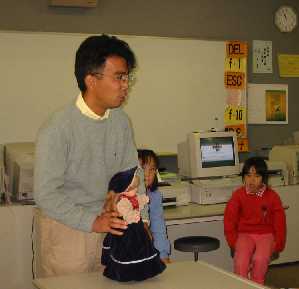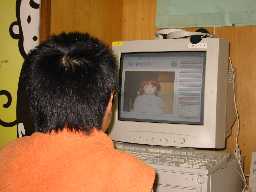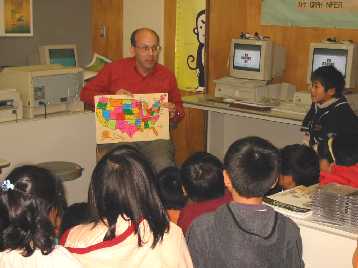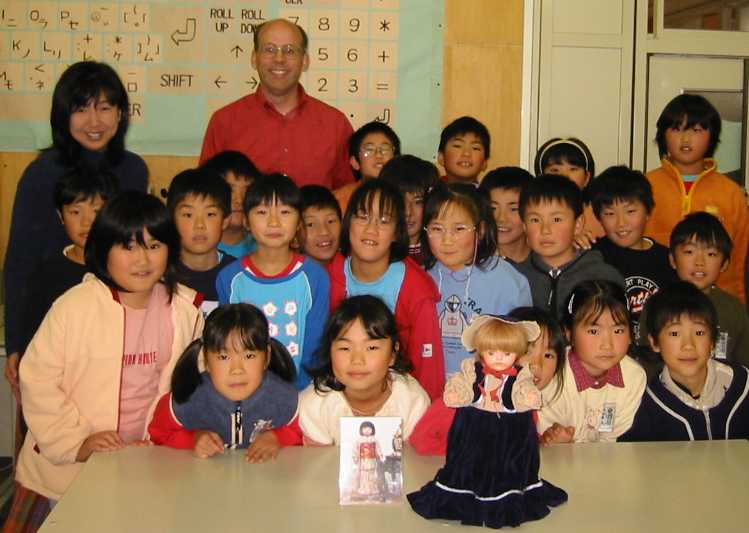|
|
|

|

|
Mr. Matsuura Explains
Betty Jane's History
|
|
|
My visit to Sanbongi Elementary School in Miyagi
Prefecture was unique among the 13 schools in that computer technology was
used to teach about the Friendship Dolls. I participated in a meeting in the
school's computer room with 25 students in the third-grade class of Ms.
Kuniko Chiba. Mr. Hiroyoshi Matsuura, the team teacher at Sanbongi, began by
explaining briefly the history of the Blue-eyed Doll at their school and then
asking the students how they felt toward the doll. I
was a little bit surprised when several said they were afraid of the doll,
maybe because it was the first time they saw the doll up close and because it
looked so different than them.
|
|
|

|
|
PC-based Material
on Friendship Dolls
|

|
|
|
The students on their own PCs followed Mr. Matsuura
as he went over the school's web page on Betty Jane, the Blue-eyed Doll
received by the school from America in 1927. The students then briefly looked
at the English translation I had done of the same web page. Mr. Matsuura then
introduced to the students the PC-based material on the Friendship Dolls, which
he had developed about five years ago. This material contained photos, a
script, and sound about Miyagi Prefecture's Blue-eyed Dolls and about the
history of the Friendship Dolls. The children could click the mouse to choose
items from various menus, and they used earphones to hear the commentary.
However, that day there were some problems with the PC server, so Mr. Matsuura
had to lead the students together through the material, which they were able to
watch and hear at their own PCs. The PC-based material contains about 30 to 40
separate pages with the contents organized by various menus. At the time Mr.
Matsuura created the material, only four Blue-eyed Dolls had been found in
Miyagi Prefecture, and now that number has increased to eight.
I then talked with the students about the 58
elegant dolls (Torei Ningyo) sent to America to show Japan's gratitude
for the Blue-eyed Dolls received from America. As a present for the school, I
had brought a beautiful photo of Miss Miyagi from Margaret Corbet, who now owns
this Japanese Friendship Doll originally sent to America in 1927 from Japan.
None of the students had any idea about the doll when they saw the photo, and
they were surprised to hear it was a Japanese Friendship Doll named Miss
Miyagi. I read a letter that accompanied the photo. Below is the English
version of the letter:
|
Thank you
very much for giving this beautiful Torei Ningyo in 1927. Miss Miyagi came
from Japan to Kansas in 1928 as a Japanese-American Friendship Ambassador.
Even now she delights American children. From last year to this year Miss
Hyogo and Miss Miyagi were shown as sisters at a special exhibit at a museum
in Missouri, the state next to Kansas.
The American Blue-eyed
Dolls and the Japanese Torei Ningyo are precious symbols of friendship and
peace. We want to always take good care of Miss Miyagi.
We would be delighted
if you would place Miss Miyagi's photo next to your school's Blue-eyed Doll.
Margaret Corbet and Bill
Gordon
|
|
|
|
|
|

|

|
Showing My Home State
on a US Map
|
|
|
After I talked about America, the students asked
me many questions about the favorite foods, games, TV programs, stars, and
sports of American children. Mr. Matsuura asked me why I am so interested in
the Blue-eyed Dolls. I explained that in general I really have no interest in
dolls. Instead, my reasons for doing a web site on Friendship Dolls are my
interests in Japanese history, the Japanese language, the Internet, and web
site construction. Finally, and most importantly, I find Friendship Dolls to
be a good way to make friends with many Japanese people.
During lunch the principal explained that the
school was founded in 1872 and now has about 450 students, although in the
past it had as many as 1,000. The photos of past principals since 1872 gave me
a real sense of the long history of the school. Several items and newspaper
articles related to Betty Jane, the school's Blue-eyed Doll, were shown to me.
The doll has three complete set of clothes, two new sets and one original set.
Mr. Matsuura gave me copies of several old newspaper articles about Betty
Jane, and Ms. Chiba gave me a beautiful dyed furoshiki (wrapping
cloth).
As I left the school building, I was surprised
to see all of Ms. Chiba's 25 students gathered outside to say goodbye to me. I
shook hands with each child, and I was a little sad as I waved goodbye to the
children.
|
|

Third-grade Class with Betty Jane and Miss
Miyagi's Photo
|
|
|